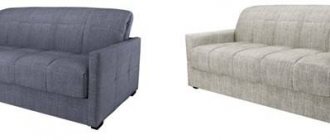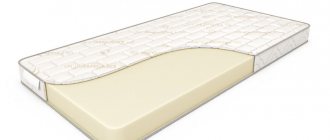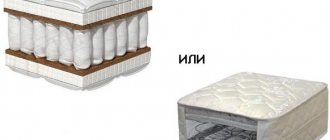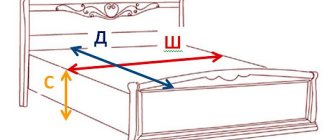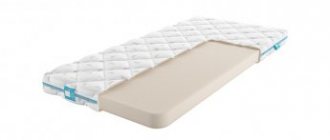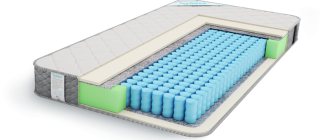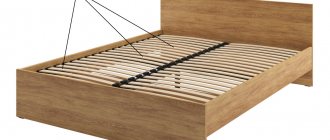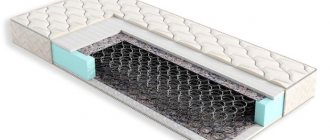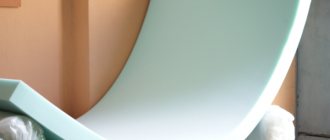Good health directly depends on the quality of your sleep. To get a good night's sleep, you need to choose a mattress that will meet the requirements for a good sleeping place. Recently, products filled with polyurethane foam (PPU) have become popular among buyers. They are distinguished by a high degree of comfort and a budget price. It remains to be seen whether they are as safe for health as the manufacturers say.
What is polyurethane foam?
Polyurethane foam is a synthetic material with a cellular structure that belongs to the group of gas-filled plastics. In everyday life it is often called “foam rubber”, but this is not true. Polyurethane foam is of high quality, it is more elastic and durable.
Thanks to a unique production technology (plastics, being in a liquid state, foam and harden), the material acquires a porous structure that contains a large amount of air (up to 98%). Polyurethane foam layers are lightweight, which greatly simplifies their operation.
What to remember when buying a mattress for a child
Children are more sensitive to harmful substances. When you buy a mattress for a child, pay special attention to the ventilation system and design of the product. Be interested in brands that back up their claims about environmental friendliness with specific facts at each stage of production.
Take the time to check the quality certificates from the manufacturer. Follow the same requirements as for adult mattresses.
After purchasing, monitor your child’s condition after sleep: even minor allergic symptoms cannot be ignored.
Areas of application of polyurethane foam
PPU or polyurethane foam, due to the presence of numerous pores, has high thermal insulation properties and a high degree of elasticity, which determined the scope of its application. The material is widely used in:
- construction as insulation;
- in the production of upholstered furniture and mattresses;
- as a filler for soft toys;
- for the production of sponges for cleaning needs;
- filters;
- rollers for painting work.
For upholstered furniture, mattresses, higher quality polyurethane foam is used. In other areas, lower grade material can be used.
Component composition of polyurethane foam
To make polyurethane foam, a mixture of two polymers is used:
- polyisocyanate;
- polyol.
The substances are mixed in a liquid state and undergo a foaming process. They are the main components of the solid part of the material, which accounts for a smaller part of the total composition. Additional elements are
- flame retardant additives;
- phenol;
- tertiary amine;
- toluene;
- phosphorus.
Most of the foam is made up of gaseous substances. This can be ordinary air or carbon dioxide, depending on the scope of application of polyurethane foam.
Why do mattress allergies occur?
The mattress itself is not an independent allergen. The cause of an immune reaction usually lies within the product and is caused by specific irritants. Here are the main factors for the occurrence of allergic manifestations after contact with the product:
Found in a new mattress
- Natural production materials. You should not buy mattresses with fillings of plant and animal origin - these are natural allergens. Below we will dwell on this issue in detail.
- Solvent based adhesive. The formaldehyde it contains provokes a negative reaction in the body. It is safer if you use hot melt adhesive - an adhesive that becomes liquid under the influence of temperature and does not contain solvents.
Accumulate over time
- Dust mites. Microscopic insects invisible to the human eye. They feed on dead skin particles and live in colonies in old mattresses, sofas, beds and pillows.
- Mold fungus. It originates in a humid, warm environment and grows quickly. It usually appears as a result of regular excessive sweating of the sleeper, snacking in bed, and poor cleaning of the mattress surface.
Olesya Ivanova, allergist-immunologist, candidate of medical sciences: We all lose skin cells every day. Scientists estimate the loss to be about 1 million dead skin cells every 24 hours. Dust mites feed on this organic debris, which is why they feel right at home in a person's bed. Although dust mites themselves do not cause allergies as organisms, their droppings contain proteins that can cause an allergic reaction. The number of mites reaches a maximum at temperatures above 20 C and humidity above 80%.
Explore the causes of allergies
At the first suspicion of an allergy, it is important to do a comprehensive test (allergen test) and find out your irritants. After all, even the “hypoallergenic” mark on a mattress does not give a 100% guarantee - the body can react to any component of the product. Or the reaction could be caused by pets or plants rather than the mattress components. Forewarned is forearmed.
Properties of polyurethane foam
Polyurethane foam has both positive and negative properties. The latter are not critical when using the material in construction or in the production of cleaning, cleaning, and washing products. But we should not forget that they can be dangerous.
For upholstered furniture and mattresses, high-quality polyurethane foam is used, which has practically no negative properties.
Positive properties
- Low thermal conductivity.
- Waterproof.
- Vapor tightness.
- Thermal insulation characteristics.
- Waterproofing properties.
- Noise insulation.
- High adhesion.
Negative properties
- Does not tolerate direct sunlight.
- It's getting dark.
- It dries out and crumbles.
Which one is used?
The material is used in a variety of fields and selected for different needs according to certain characteristics. For mattresses, the density of foam rubber is important; the service life of the product depends on it. They use polyurethane foam with a density from 25 to 40 kg/m3. The density is indicated by two numbers after two letters in the name, the next two numbers indicate the hardness index.
Mattresses are made from the following types of foam rubber:
- Standard PPU. The brand is designated ST.
Foam rubber ST. Used for children's mattresses. Foam density from 25 kg/m3. - With increased rigidity. Its designation is EL. A popular suggestion is the EL2240 brand. This is a budget option; you shouldn’t expect longevity from such a mattress; it will only last about five years. The EL2540 will last a couple of years longer, but the EL2842 can remain in good condition for ten years.
Foam rubber for a mattress with increased rigidity EL. Loads allowed on it are 90-100 kg. - The brands HR and VE denote latex foam; such foam is used for sofas and other luxury furniture. You can purchase such foam rubber for furniture at Leroy Merlin. This type of foam is also used in thin orthopedic sofa mattresses.
Is polyurethane foam in a mattress harmful?
Recently, a large number of rumors have appeared about the dangers of mattresses with polyurethane foam filling. They are explained by the composition. Anyone would be frightened by chemical dyes, phosphorus, formaldehyde and even arsenic.
But it must be taken into account that all these substances reacted during the foaming process and after the foam hardened they became completely harmless. They can only become active when the material is heated to 200 °C or during combustion. In an apartment it is impossible to obtain such a temperature, which means that substances hazardous to health will not be released.
It is better to pay attention to the positive characteristics of polyurethane foam mattresses:
- elasticity;
- anatomical;
- hypoallergenic;
- affordable price.
The last argument turns out to be the most effective. It is this that makes mattresses with polyurethane foam in demand among consumers.
Advantages
- Elasticity and resilience: the product allows you to well support the body during sleep, which ensures comfortable, complete rest.
- Affordable price - compared to analog mattresses, these pleasantly surprise with their cost combined with quality. The price of a PU foam mattress is quite acceptable for any category of the population, but in pursuit of cheapness the main thing is not to overdo it. Still, the cheapest model will be inferior in quality and durability, and as a result, instead of the expected 10 years, the mattress will last you only a third of this period. But at the same time, you shouldn’t overpay. For example, mattresses “filled” with bilaxilast and waterlatex will cost more than polyurethane foam, although their characteristics are exactly the same.
- Viscosity – PU foam gives mattresses softness and makes them pleasant to the touch. In addition, it is optimal for people with excess body weight due to its ability to withstand strong pressure. Purchasing such a mattress easily solves the problem of spouses of different weight categories sleeping together. The fuller partner, due to its viscosity, does not press down the mattress so much that it is noticeable on the other side, and as a result, the lighter one does not slide down to the middle of the mattress.
- Orthopedicity is ensured by the ability of products to repeat the anatomical curves of the human body. Resistant to deformation, they are suitable for people with impaired spinal function.
- Air exchange is achieved due to the cellularity of polyurethane foam and guarantees the mattress excellent hygiene and ventilation.
- Ease of transportation. Springless mattress models are convenient to roll, and when you buy them, you can immediately take them home by rolling them up, without waiting for them to be delivered to you. When you unfold the mattress, it will return to its original appearance without signs of deformation.
Pros and cons of a polyurethane foam mattress
Like all mattresses, models with polyurethane foam filling have their advantages and disadvantages. All that remains is to analyze and decide whether their advantages are important for the consumer and whether the disadvantages are so critical. To reduce the number of shortcomings, it is recommended to study information about the types of polyurethane foam and their properties.
Advantages
The main advantage of polyurethane foam mattresses is their price. With other positive characteristics, they turned out to be worthy competitors to expensive models with natural fillers or materials created using innovative technologies.
Polyurethane foam mattresses
- elastic;
- breathable;
- have excellent orthopedic characteristics;
- light weight, which simplifies operation.
By choosing a model with PU foam filling, you get a budget mattress that will delight its owners.
Flaws
There is only one drawback - the risk of exposure to direct sunlight. This is especially important to consider in mattresses with removable covers.
The opinion about the harmful vapors emitted by the material is controversial today. If the mattress is not a fake, then we can safely say that it is safe for the human body.
Myths and truth about foam rubber
First, we will debunk several myths about foam rubber, and then move on to discussing the topic of what foam rubber is needed for a mattress. Let us clarify once again that foam rubber and polyurethane foam are the same thing (different names for the same material). And if the seller claims that there is some difference between foam rubber and polyurethane foam in mattresses, this fact only indicates the ignorance of this consultant.
Myth 1. Foam mattress is too soft
For many, this stereotype was formed in Soviet times or as a result of the obvious (bath and kitchen sponges, packaging foam rubber are actually made from soft grades of polyurethane foam). However, many consumers do not even realize how diverse modern polyurethane foams are (there are more than 130 brands). The development of new compositions and improvement of old foam formulations is ongoing.
Reference! In addition to standard brands, there are reinforced (increased rigidity), extra-hard, highly elastic and viscoelastic brands of foam rubber for mattresses.
Myth 2. Foam mattresses are not recommended for people with spinal diseases
This stereotype is destroyed under the onslaught of facts. Mattresses made from certain brands of polyurethane foam have medical certificates and are used as orthopedic products.
New generation foam rubber - memory polyurethane foam - is a special category. In many cases, they are simply irreplaceable - as an anatomical top covering or a full-fledged filler in mattresses and pillows for people with vascular problems, diseases of the joints, bones and spine, as well as for the elderly.
Myth 3. Foam mattresses are short-lived
The lifespan of a foam mattress directly depends on what type of foam you choose for the mattress (meaning the brand). The higher the density of the foam filler, the longer the mattress will last without losing quality characteristics. The service life of mattresses made from high-quality polyurethane foam is up to 10 years (as well as blocks of independent springs).
Myth 4. Foam mattress is synthetic and causes allergies
A foam mattress purchased from a reliable manufacturer does not emit an odor (only a characteristic odor that quickly dissipates when unpacked), does not emit harmful substances, and is hypoallergenic. The CertiPUR (European standard certification) mark on the packaging confirms that even the foam production process did not harm the environment, being strictly controlled at all stages.
